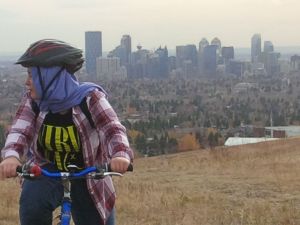This article was originally written for @CBE182 a twitter account where teachers, administrators, consultants from the Calgary Board of Education share out best practice ideas and celebrate the work of teaching and learning in our school division. This article is the full version of the shortened article found on CBE182. If you aren’t following CBE182 yet, I’d encourage you to do so – you’ll find a different educator sharing out ideas every school day of the year.
Here is the extended version of the @CBE182 article published on Oct 30, 2014.
CBE 182 – A Day in the Life of an Outdoor/Environmental Education Consultant – Roy Strum
Last week I had the chance to get out for a ride with a group of grade 9 students and their teacher from Simon Fraser School. It was the sort of experience that made me reflect about the place for outdoor physical activity in our current education culture. I’ve been reading Hattie’s Visible Learning for Teachers the last couple of weeks. I’ve been mulling over connecting the dots between outdoor education and learning that addresses both surface and deep knowledge and is a part of constructing new ideas. Can physical learning be an exemplar of visible learning? Or is it merely supplementary to the important learning work that can happen with a passionate teacher within a classroom?
Here are my observations from my day with Simon Fraser School. Hattie would say that Visible Learning occurs when: learning is the explicit goal; the learning task is appropriately challenging; the teacher and student seek to ascertain whether and to what degree the challenging goal is attained; there is deliberate practice aimed at master of the goal; there is feedback that is given and sought; there are active, passionate, and engaging people participating in the act of learning. Given this definition, I’d say some impactful learning occurred on our mountain bike trip to Nose Hill Park.
Learning is the explicit goal – The teacher had framed the day as a skill development experience focused on cross country mountain bike riding skills. He had planned the use of gps units as a skill building experience. The afternoon was about learning – learning to ride your bike in undulating variable terrain and to be able to use a piece of technology to locate yourself in an expansive natural setting.
The learning task is appropriately challenging – Nose Hill Park provides a variety of terrain to challenge riders – from narrow single track, to double track trails, options for riding on paved paths, or technical sweeping flowy descents. Terrain that would encourage good riding technique and make skill instruction relevant.
There is deliberate practice aimed at mastery of the goal – instruction and demonstration of technical riding skills were offered, opportunities to practice a skill on appropriate terrain were present, such as neutral position on descents, repeated opportunities to practice ascending, flat ground riding, and descending were provided as part of the two hours of riding in a natural area.
There is feedback that is given and sought – Riding alongside students as they ride a big climb provides a teacher to suggest and show them how to move forward on their saddle, or drop their elbows or wrists – as a result, skill level improves for the student and their ease in ascending a long climb on their bike improves. This results in improved student confidence in their abilities and subsequent improved physical skill performance efficiency. In fact, what also happened on our ride at Nose Hill was students began to offer feedback to other students about their body positions, the riding skills; peer teaching what they had learned to peers who needed some more instruction.
There are active, passionate, and engaging people involved with learning – when you’re riding some twisty undulating single track trail, and you’re the person in charge of your bike, you get engaged pretty easily, otherwise you end up on the ground. The teachers from Simon Fraser School shared their passion and interest in spending time outdoors engaged with fun, active physical activity.
None of this really comes as a surprise to me or will it to many others. Cross country mountain biking at Nose Hill Park has inherent appeal to students – there is adventure and novelty and an experience that has immediate effects on later cycling experiences. And let’s face it, for many, many students, getting a chance to improve their cycling skills at school may be the only formal instruction they ever get focused on riding trails on a mountain bike. On top of this, Hattie’s research identifies outdoor education as a significant influence on student achievement. When students are engaged in deliberate practice in a challenging learning task where feedback is offered and tasks are structured so that learners can attain the learning goals then visible learning happens.
I’m pleased to say, some great visible learning happened last week with Simon Fraser School’s outdoor education class and it happened at Nose Hill Park while kids were riding their bicycles. Hats off to teacher John Komori for his great work with his students.


